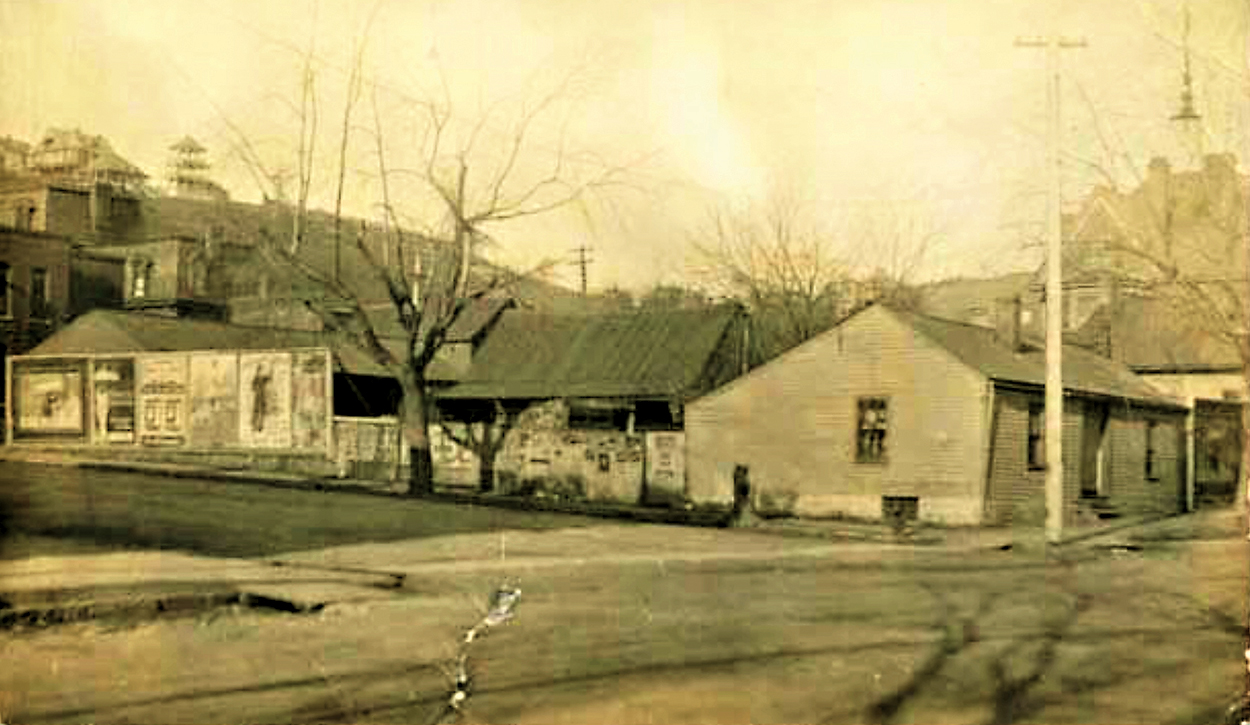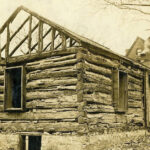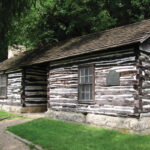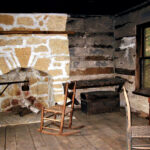The historic log cabin sitting proudly on a hilltop at Dubuque’s Mathias Ham Historic Site has the distinction of being the city’s and Iowa’s oldest remaining house. Most historians agree the cabin originally located at Second and Locusts Streets near St. Raphael Cathedral was built by French Canadian fur trapper Louis Arriandeaux around 1827-28. Several stories center on the history of the cabin and its original owner.
One legend claims that pioneer priest Father Samuel Mazzuchelli said mass on the first Sunday of every month from the south room of the cabin for Catholic settlers, and even lived in the cabin on occasion. Another story claims that Arriandeaux married Chief Blackhawk’s daughter (some say sister) and was killed by Indians near Sinnipee, WI, before the Blackhawk War. Other noteworthy claims say the structure was the site of a speech by Ansel Briggs (first governor of Iowa), and home to the state’s first Franklin stove.
Some say Arriandeaux’s widow sold the cabin to barber Samuel Ellmer, a ventriloquist who convinced the Indians he had magical powers. Since the Indians feared Ellmer, his cabin became a safe haven for early settlers escaping from Indians, as the Indians also feared the home of the “White Medicine Man.”
Evidence in the form of a sale document reported by C.H. Gratiot states that Arriandeaux lived in the cabin until 1833. The contract says:
Dubuque July 13, 1833
Mr. Baptiste LePage bot [bought] of Louis Reando [Louis Arriandeaux] a house and lot; the house to be covered with clapboards [wood shingles] 3 feet shaved, the roof to be put in workmanship manner, he paying me 1 horse, saddle, bridle, collar, and harness valued at $70.00. His house to be delivered in eight days after this date.
The document was signed with an X. Someone wrote “Louis Reando” by the X.
Ownership of the cabin becomes clearer when it was purchased by William Newman in 1846. Newman, an Irishman born in Ireland around 1810, operated the Newman & Duffee blacksmith and wagon repair shop in the cabin at Second and Locust.
Newman’s blacksmith shop hired A.A. Cooper as an apprentice. Much later, Cooper would become the founder of the A.A. Cooper Wagon and Buggy Co. Following a four-year apprenticeship, Cooper began working as a blacksmith, earning $26 a month.
By March 1850, Cooper was able to buy out Duffee and form a partnership with William Newman. Together, they expanded their operation to also include wagon manufacturing. Six months later, an addition to the original shop was built; and in less than a year, a new building across the street was acquired.
Eventually, A.A. Cooper purchased the log cabin for $150 in 1850. In 1851, Cooper married Mary Smith in a ceremony held on the threshold of the cabin and officiated by Bishop Mathias Loras. (Some say Mary was Newman’s niece, while others say he became her guardian after her parents died of cholera.) By 1862, Cooper had saved $60 – enough to purchase Newman’s share of the profitable business.
The Coopers kept the log cabin in the family and eventually passed the home down to their son William who died in 1915. Following William’s death, the old cabin was slated for demolition to accommodate the construction of a new Standard Oil Co. gas station.
Frederick Bissell became one of Dubuque’s early preservationists when he observed logs under the white-painted clapboards as the demolition got underway. Fortunately, the clapboards had helped preserve not only the original logs but also the clay chinking between them. Bissell realized the value of the old cabin and the history it represented, and launched a campaign to save the structure. With the help of generous citizens and the Park Board, the cabin was purchased from the Cooper family for $450.
In 1917, the cabin was moved to Dubuque’s Eagle Point Park, where it served as a picnic pavilion for 50 years before it was moved to the Mathias Ham Historic Site in 1965. The Park Board voted to remodel the cabin in 1949-50. At that time, workers replaced rotted logs, windows, and doors and added a new shingle roof at a cost of $5,000.
While serving as a park pavilion, the old cabin offered a spectacular view of Dubuque’s Lock and Dam No. 11. The popular pavilion could accommodate up to 24 in each of the two rooms. The Dubuque Chapter of the Daughters of the American Revolution placed a commemorative, bronze plague on the cabin in 1958, noting that the structure was the oldest log cabin in Dubuque Co.
Many Dubuquers were upset that the historic log cabin was open to the public however, and at risk of possible damage and vandalism. Eventually, preservationists’ concerns prevailed; in June 1965, the historic log cabin was relocated to the grounds of the Mathias Ham Historic Site where it came under the care of the Dubuque County Historical Society. In October 2020, the cabin underwent a major restoration and preservation project that included new logs and roof.
Visitors to the log cabin will note the dogtrot style of the construction, in which two rooms are connected by a covered breezeway which allows airflow to cool the rooms. While unusual for this part of the country, dogtrot construction is a popular model for southern and coastal areas. It’s easy to imagine William Newman working as a blacksmith on one side of the cabin while eating and sleeping in the other side during the early and mid 1800s when Dubuque was a brand new town, just getting established on the banks of the Mississippi River.
The Mathias Ham Historic Site reopened for the 2022 season in late May. During the summer the site is open Thursdays-Sundays, 11 AM-4 PM, and Labor Day, 11 AM-4 PM.
This article is part of the Shades of Dubuque series, sponsored by Trappist Caskets, hand-made and blessed by the monks at New Melleray Abbey. More at trappistcaskets.com.







Comment here